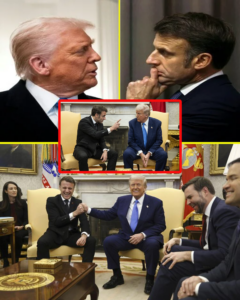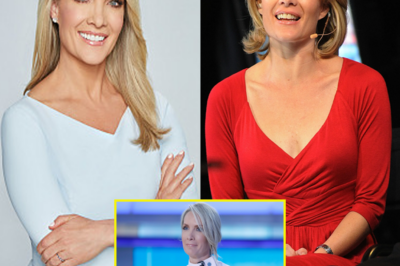The Surprising Details You Won’t Expect! Trump and Macron’s ‘Friendly’ DC Meeting – What Really Happened Behind Closed Doors

In a surprising turn of events, former U.S. President Donald Trump and French President Emmanuel Macron recently met for what was billed as a “friendly” encounter in Washington, D.C. While the public-facing aspect of the meeting appeared cordial and constructive, the true details of their private discussions have sparked intrigue, speculation, and even concern from political insiders. What was really said behind closed doors, and how could this meeting reshape the future of U.S.-France relations?
A Friendly Facade: Public Remarks and Diplomatic Smiles
The meeting began with both leaders presenting a unified front for the cameras. Macron, known for his diplomatic tact, was quick to praise Trump’s leadership style, describing it as “bold and effective.” Trump, in turn, complimented Macron for his handling of European affairs and the challenges the continent faces. Their public remarks were positive, highlighting shared goals and mutual respect for each other’s leadership.
- “I’ve always admired the way President Macron has handled tough situations in Europe,” Trump said during the public portion of the meeting.
- “France and America have always been strong allies, and this meeting is a testament to that,” Macron added, visibly at ease.
On the surface, this moment of camaraderie seemed like a rare instance of goodwill between two leaders who had historically not always seen eye-to-eye. But political insiders suggest that there was much more to this meeting than the cameras revealed.
What Really Happened Behind Closed Doors?
While the public-facing portion of the meeting was all smiles and mutual respect, the true discussions that took place behind closed doors have raised eyebrows. According to sources close to the talks, the two leaders addressed a range of critical issues, including NATO, defense spending, and economic cooperation. However, it was their differing views on global leadership that took center stage in the private conversations.
- “There were some serious disagreements behind closed doors,” a source with knowledge of the meeting revealed. “Macron pushed for greater European independence in terms of defense and foreign policy, something Trump has always criticized. The talks got heated at times, with Trump insisting that NATO needs to be more focused on U.S. interests, while Macron advocated for a stronger European stance.”
These differences were particularly evident in discussions surrounding defense budgets and military cooperation, with Macron calling for increased European autonomy in terms of security policy. Trump, who has long advocated for NATO members to pay more for their own defense, reportedly disagreed with Macron’s calls for more independence, emphasizing the importance of U.S. leadership in global security.
The Unexpected Tension: What Was Really at Stake?
Beyond the discussions on military and economic matters, the private meeting also touched on more personal dynamics between the two leaders. Despite their seemingly friendly interactions, there was underlying tension regarding their divergent views on global governance and the role of the U.S. under Biden’s leadership.
Sources claim that while Macron acknowledged the need for collaboration with the U.S., he expressed concerns about the Biden administration’s approach to European issues. Macron, who has positioned himself as a defender of European sovereignty, reportedly urged Trump to continue supporting European unity, while Trump warned that European leaders must do more to take responsibility for their own security and economic future.
- “Macron knows he can’t rely solely on the U.S. for Europe’s future security, but he’s hesitant to take full responsibility for it,” said one diplomatic observer. “This private conversation revealed the tension between an independent Europe and the necessity of U.S. involvement.”
While Macron remained diplomatic, it’s clear that both leaders recognized the shifting dynamics of global power, with Trump’s support for European independence at odds with Macron’s vision of a stronger, more autonomous Europe.
What Does This Mean for U.S.-France Relations Moving Forward?
As the meeting concludes, the question remains: How will the outcome of this diplomatic encounter impact U.S.-France relations in the long term? Publicly, both leaders are keen to maintain the image of strong allies, but privately, it’s evident that they have very different visions for the future of global leadership.
For Trump, this meeting may be seen as a step toward reasserting his “America First” foreign policy, with an emphasis on U.S. interests at the forefront of global conversations. For Macron, it signals the ongoing struggle to balance European autonomy with the need for strong partnerships with the U.S. and other global powers.
Final Thoughts: A Diplomatic Dance or a Turning Point?
While the public-facing meeting between Trump and Macron was described as “friendly,” the behind-the-scenes discussions suggest that the two leaders have diverging priorities for global leadership. Whether this private exchange marks a turning point for U.S.-France relations or is simply a diplomatic dance remains to be seen.
As both leaders continue to navigate the complexities of global politics, one thing is clear: the dynamics between the U.S. and France are evolving, and this meeting may have far-reaching implications for how the two countries cooperate—or clash—in the future.
🔥 What do YOU think? Was this meeting just a diplomatic façade, or will it lead to real change in U.S.-France relations? Share your thoughts and let’s discuss the future of global leadership! 🔥
News
“Fox News’ The Five Makes History by Beating CNN and MSNBC—First Non-Primetime Show to Dominate Cable News Ratings!”
“Fox News’ The Five Makes History by Beating CNN and MSNBC—First Non-Primetime Show to Dominate Cable News Ratings!” In a…
“Why Is Dana Perino Missing from Fox News? Fans Are Fearing the Worst After Her Sudden Disappearance”
“Why Is Dana Perino Missing from Fox News? Fans Are Fearing the Worst After Her Sudden Disappearance” Fox News viewers…
“Ryan Seacrest Teases Engagement and Reveals a Mystery Woman—Fans Can’t Stop Speculating About His New Love!”
“Ryan Seacrest Teases Engagement and Reveals a Mystery Woman—Fans Can’t Stop Speculating About His New Love!” Ryan Seacrest, the ever-charismatic…
“Ryan Seacrest’s Secret Bad Habit That Ruined His Partnership with Kelly Ripa on Live—Is This Why They Went Separate Ways?”
“Ryan Seacrest’s Secret Bad Habit That Ruined His Partnership with Kelly Ripa on Live—Is This Why They Went Separate Ways?”…
SHOCKING TWIST! Sidwell Reveals Spencer Didn’t Die—He’s Alive, and What He’s Been Hiding Since His “Death” on General Hospital Will Leave You Speechless…
SHOCKING TWIST! Sidwell Reveals Spencer Didn’t Die—He’s Alive, and What He’s Been Hiding Since His “Death” on General Hospital Will…
It’s Official: CBS Drops $700 Million to Launch Megyn Kelly & Candace Owens as The View’s Ultimate Rivals—This Explosive Morning Show Duo Promises No Censorship, No Apologies, and No Holding Back!
It’s Official: CBS Drops $700 Million to Launch Megyn Kelly & Candace Owens as The View’s Ultimate Rivals—This Explosive Morning…
End of content
No more pages to load












